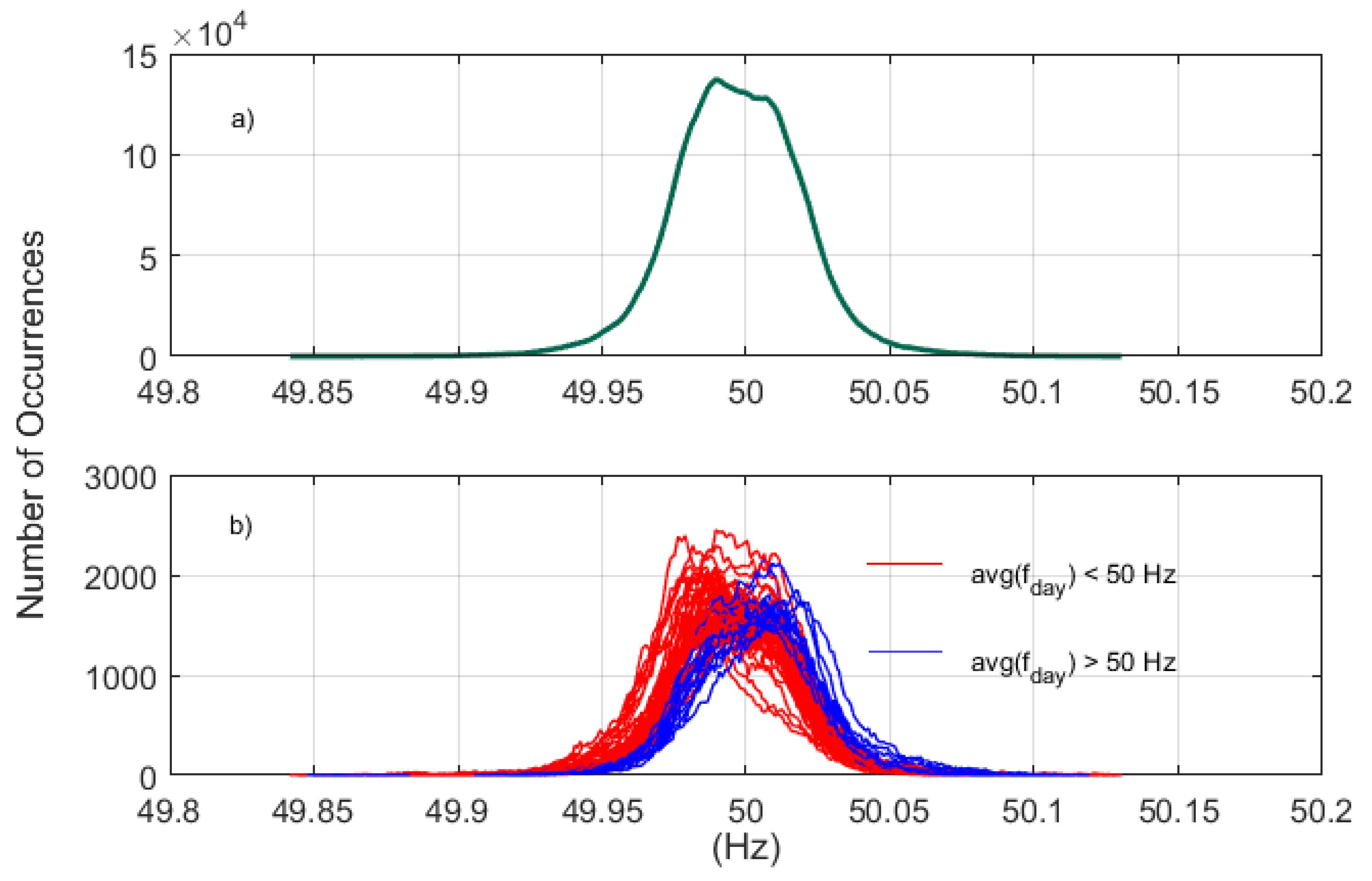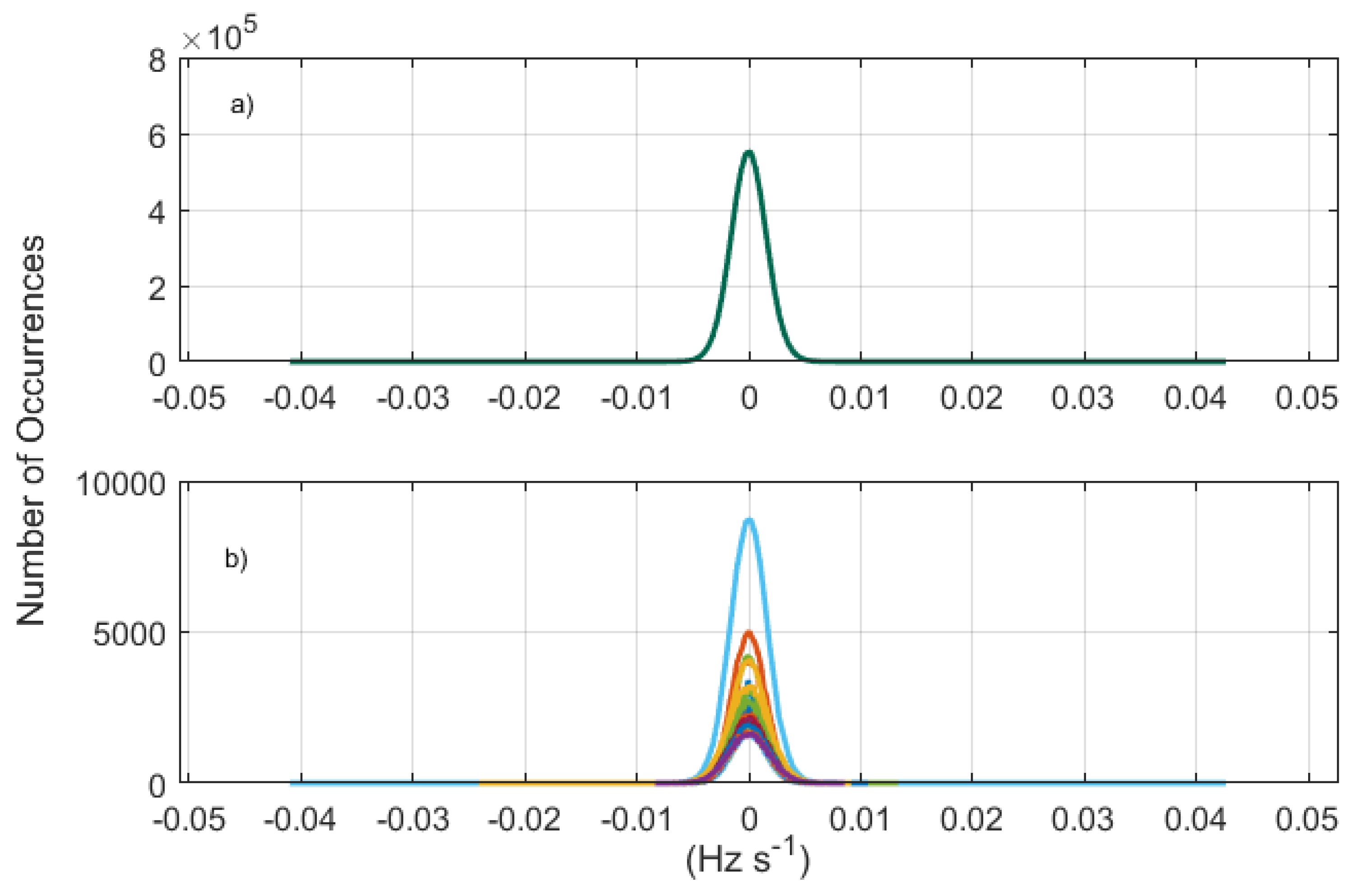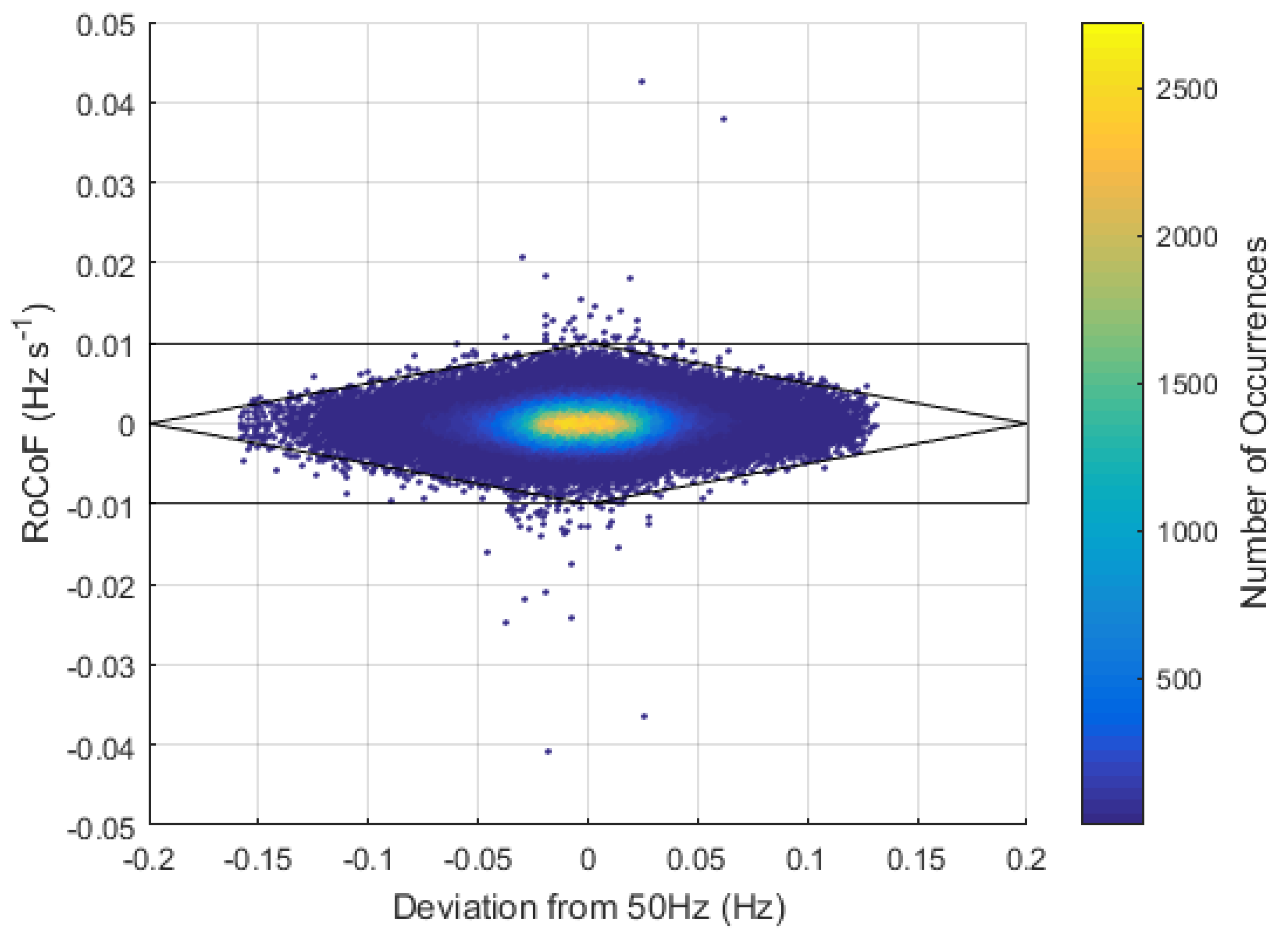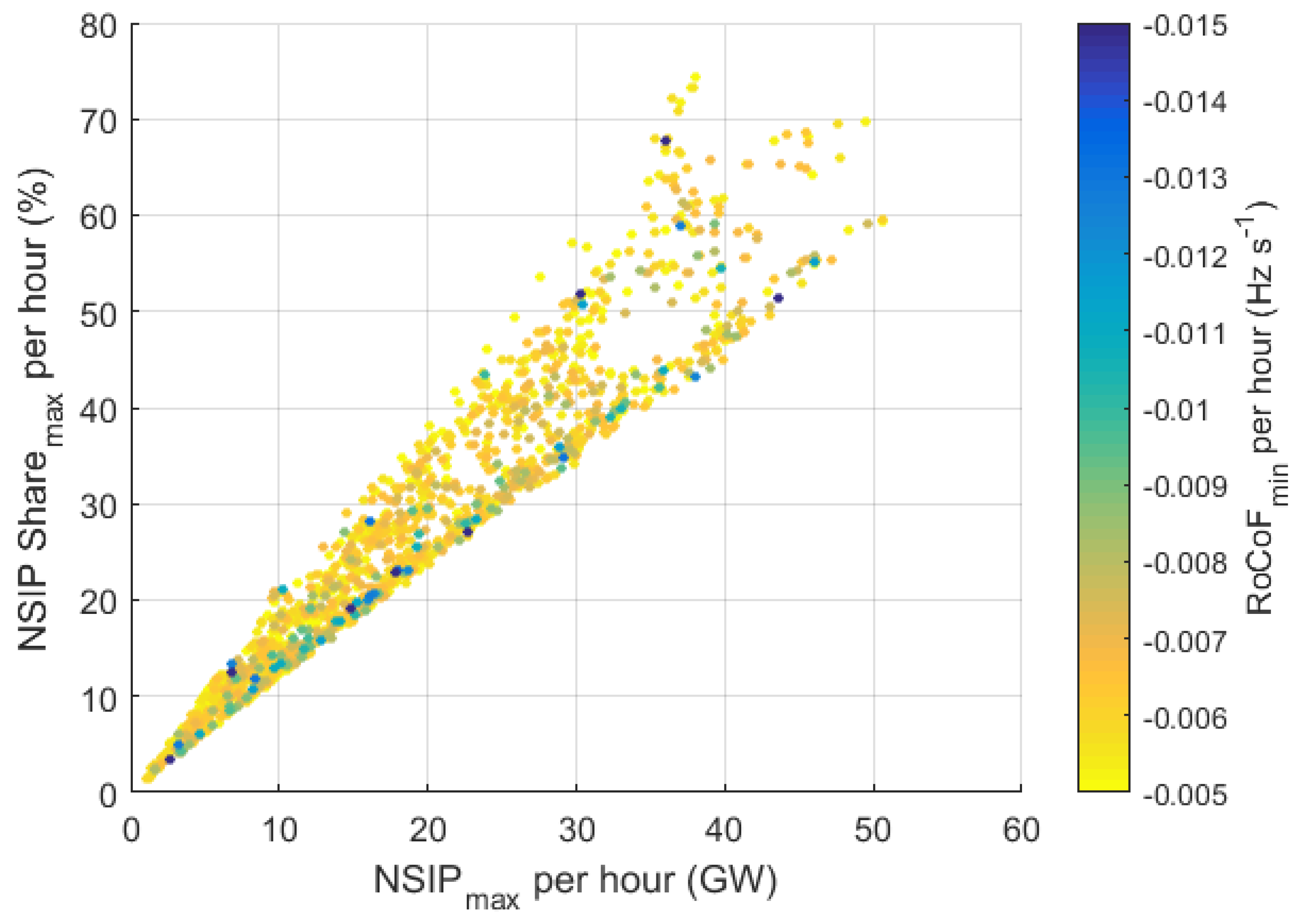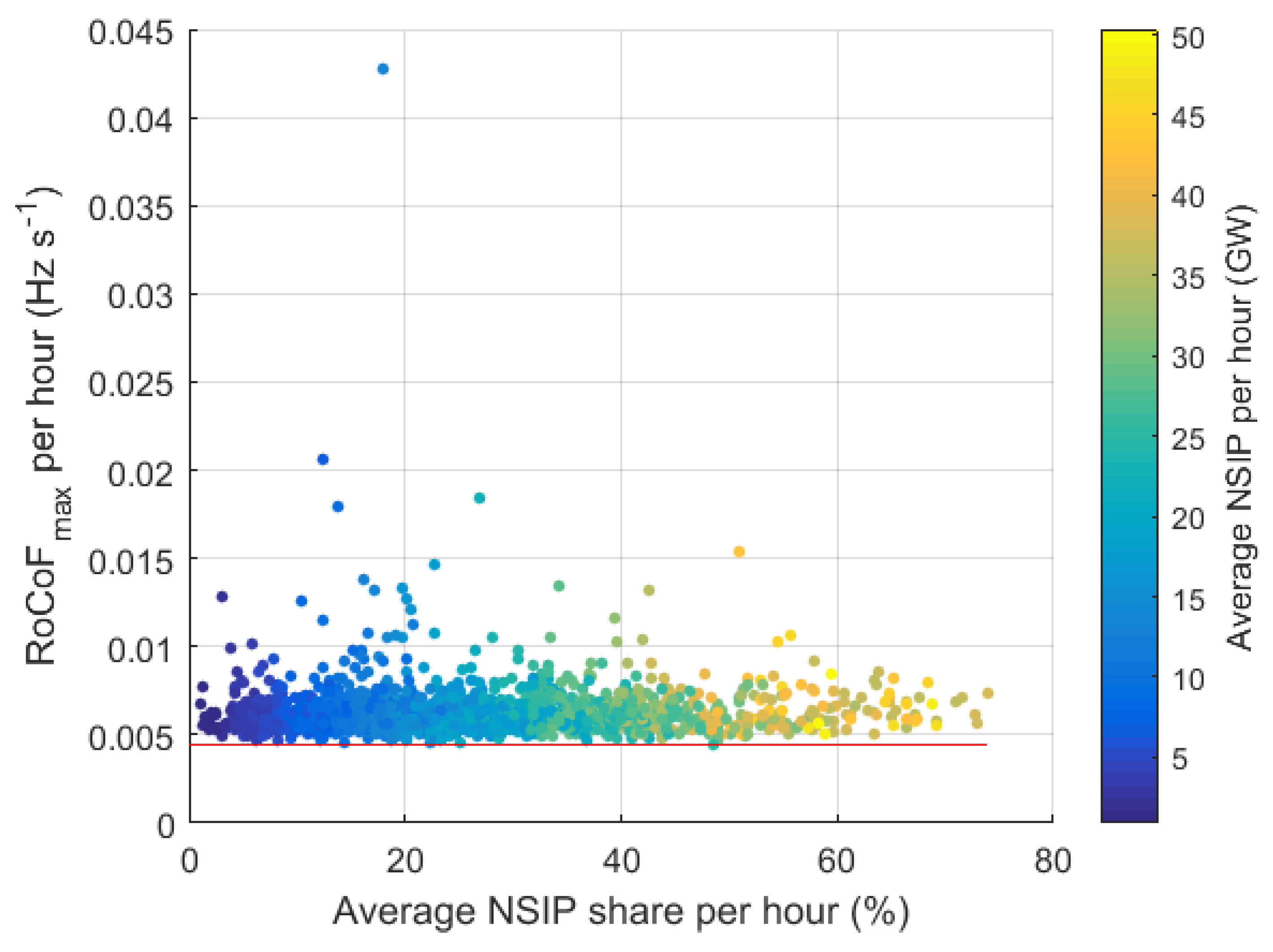1. Introduction
Conventional synchronous generators are usually electromechanically coupled to the power grid. Therefore, they are rotating with synchronous grid frequency. The sum of their rotating masses (e.g., generator and turbine rotor) contribute to the system inertia [
1]. Unlike conventional generators, which inherently react to frequency changes in the system due to their inertia, non-synchronous renewable energy generators, such as Photovoltaic generators and many wind converters, provide no inertia. Moreover, their power output can be very volatile. Every imbalance leads to a deviation of the grid frequency from the nominal one, which is 50 Hz in European Continental Synchronous Area (ECSA). With the targets of the European commission for
RES share until 2020 and up to
until 2030 [
2], balancing power generation and demand therefore becomes more and more complex and even more time critical. RoCoF is the time derivative of the grid frequency, and it is inversely proportional to system inertia for a given imbalance of generation and demand. Low grid inertia due to high NS-RES penetration can lead to steep RoCoF hence system instability [
3]. Given this new complexity of the grid’s dynamics and the increased need for frequency control, RoCoF becomes a very important indicator of the grid stability.
In this paper, we investigate the relationship between NSIP and frequency based on high-resolution measurements and show that no critical state was reached. The rest of this work is organized as follows:
Section 2 summarizes related work;
Section 3 describes the data collection, preprocessing and first evaluation;
Section 4 presents the results and discussion regarding frequency variations correlated to generation and consumption data of Austria and Germany; and the conclusions are drawn in
Section 5 as well as the challenges are pointed out.
2. Related Work
The impact of NS-RES penetration on the frequency stability of the grid is tackled in numerous studies. Specifically for continental Europe, Wang et al. [
4] conducted frequency stability simulation studies over one year and showed that it is not possible to define a single critical threshold for RES share, since the behavior of the European Interconnected System (EIS) is dynamic and thus changing over time. Moreover, the increasing NS-RES penetration has a lower impact on ECSA than on small isolated power systems. However, during critical periods such as of low demand and high RES share (e.g., windy nights in the summer), the frequency can drop below the value of 49 Hz, triggering automatic load shedding in the system.
A study on the Spanish power grid considered a maximum RoCoF limit of
Hz
based on the European Network of Transmission System Operators for electricity (ENTSO-E) reference incident, and calculated the maximum wind power generation penetration that can be achieved without violating this limit [
5]. Fernandez-Bernal et al. found that a share of wind generation up to 64% for a load valley scenario, and 70.7% for a load peak scenario can be reached without exceeding the RoCoF limitation, while a share up to 82% is possible for obtaining the necessary primary reserve.
An attempt to define the limits of NS-RES penetration with regard to frequency stability of the Australian grid was presented in Ahmadyar et al. [
6] by simulating time series in various scenarios. It was concluded that, rather than a single critical NSIP, a critical range of NSIP has to be defined. For the worst case scenarios, it was shown that, at a critical RoCoF of
Hz
, the NSIP would not exceed 60–67%, with the latter increasing up to
at a critical RoCoF of
Hz
.
Time series sampling methodology was employed in an earlier study Doherty et al. [
7] to investigate the impact of wind generation on the Irish grid frequency stability, considering the maximum RoCoF and the minimum frequency value, the nadir. Various scenarios over a timespan of multiple years were examined, considering different types of wind turbines. It was concluded that a high level of wind generators, whose stored kinetic energy is not fully available to the system (e.g., Doubly Fed Induction Generators (DFIG)), can result in increased high RoCoF occurrences, including the limit of
Hz
. Below this limit, conventional RoCoF protection relays would disconnect the generator. It was pointed out that increased penetration of wind turbines, which cannot provide any inertia, in combination with greater levels of High Voltage Direct Current (HVDC) interconnection, will be challenging for the system operators in terms of frequency control. In a more recent publication towards this finding, the Irish transmission system operation EirGrid has set a limit of
to the System Non-Synchronous Penetration (SNSP) from wind generators for the year 2016 [
8].
All the referred studies are based only on simulated data and scenarios. In contrast, our study was based on measurement data. It examined the impact of NSIP of photovoltaic and wind power generators in Germany and Austria on the frequency variations and RoCoF based on high-resolution frequency measurements and recorded power generation data. The period of the analysis was two months during 18 January 2018–18 March 2018. This period is of particular interest since it includes an event of generation and demand imbalance in southeast Europe. This led to an extended period of low frequency in the European continental synchronous power grid. The study utilized data mining methods including data preprocessing, outliers and deviation detection and visualization to discover patterns and correlations in large data sets consisting of NSIP and generation data. The derived observations were used to evaluate the current impact of NSIP on the frequency variations, even during periods of increased stress of the power grid, and thus support further studies on hypothetical/simulated scenarios of higher NSIP share in the power grid.
4. Results and Discussion
To evaluate the system stability, we visualize various correlations between NSIP generation, and share, minimum and maximum RoCoF and frequency deviation from 50 Hz. The time span of the analysis is two months, which is a rather short time for generic observations. However, a data set of 5,184,000 frequency measurements of 1 s resolution and 5760 NSIP recorded values of 15 min resolution allow us to extract reliable observations for the specific time span and thus during the mentioned period of extended frequency imbalance.
The value of RoCoF in comparison with the deviation of the frequency from 50 Hz is an indicator of the grid stability. Large frequency deviations from 50 Hz and on the same time steep RoCoF reveal an unstable system.
Figure 5 depicts the correlation between RoCoF and frequency deviation for the timespan 18 January 2018–18 March 2018 in a 3-D scatter plot. The
x-axis represents the deviation of the measured frequency from 50 Hz at time
t, the
y-axis shows the RoCoF values at the same time and the
z-axis shows the number of
observations. The calculation of the number of occurrences is done in steps of 0.1 mHz
and 1 mHz respectively, to reduce the computational complexity. The visualization of the data points resembles a rhombus, from which one can observe that the most steep RoCoF values and substantial deviations from 50 Hz do not occur at the same time. Most of the observation points are included within the dashed rhombus and rectangle, which define the maximum frequency deviation and observed frequency gradients after a reference incident in the synchronous grid of continental Europe, namely 200 mHz and
Hz
, respectively [
14,
15]. Indeed, only 51 and 37 measurements exceed the limit of
Hz
and
Hz
, respectively, which corresponds to
and
of the total number of measurement points. The resulting diagram is almost symmetrical on the x-axis which is a further stability criterion for the grid. It reveals that the average deviation from 50 Hz is almost 0 and hence the average frequency of the grid is 50 Hz. Indeed, the average absolute deviation from 50 Hz for the overall measurement period is
Hz. The average frequency for the whole period is
Hz. The symmetry on the
y-axis reveals that inertia of the grid is provided similarly for positive and negative imbalances of generation and load during the period of the analysis. Therefore, the response of the grid when undergoing or surpassing 50 Hz is approximately the same. A further study examined the distribution of the frequency deviation based on measurement data during 1 April 2014–30 September 2015 ([
16], Figure 11 (case Continental Europe (CE)). The frequency deviation did not exceed
Hz and the values are concentrated almost symmetrically around 0, which aligns with our study. Furthermore, the current visualization indicates that the maximum positive and negative frequency deviations from 50 Hz are not equal; the system frequency does not exceed
Hz during this analysis period, while it does drop below 49.85 Hz, with a maximum deviation of approximately
Hz. This indicates different grid control strategies to positive and negative frequency deviations.
Continuing, the maximum NSIP per hour was compared with the minimum RoCoF per hour for the total period of the analysis, resulting in 1440 calculation points.
Figure 6 depicts a scatter plot with the
x-axis representing the maximum NSIP per hour, the
y-axis the maximum share of NSIP per hour and the
z-axis (colorbar) the minimum RoCoF per hour.
Regarding the
x and
y axes, we observe that the NSIP generation and share are proportional but also that high values of NSIP share are limited; a maximum NSIP share per hour higher than
is observed 138 times of total 1440 observation points, which equals
. The specific visualization aims to reveal a pattern regarding NSIP and extreme RoCoF values, namely here minimum RoCoF values. To avoid a biased visualization, we chose to exclude outliers of minimum RoCoF values (see
Figure 5), and therefore we set the upper
z-axis limit to
Hz
. Nevertheless, no clear correlation between maximum NSIP share per hour and minimum RoCoF per hour can be observed in this visualization. The minimum RoCoF rather than the maximum was chosen as
z-axis here, since negative RoCoF values occur more frequently than positive ones, and hence they serve better the visualization purposes.
Figure 7 and
Figure 8 depict the minimum and maximum RoCoF per hour and its correlation with the average NSIP share per hour. These two visualizations aim to reveal a correlation between steeper RoCoF values at high NSIP share. The resulting scatter plot of 1440 data points (1 h calculation step for 60 days) reveals no significant decrease or increase of minimum and maximum RoCoF when NSIP share takes higher values. The red horizontal lines stand for the minimum and maximum of RoCoF values per hour in
Figure 7 and
Figure 8 , respectively. The data points are mostly aligned with these two horizontal red lines, which indicates no substantial RoCoF increase or decrease. Therefore, the increase of RoCoF as depicted in
Figure 3 from 2 March 2018 and onwards cannot be attributed to the higher NSIP. Comparing
Figure 7 of the current study with Figure 11 of the study on the Australian grid, as presented in Ahmadyar et al. [
6], we notice that, in the latter, there is also no significant increase of RoCoF for an NSIP share up to approximately 70%, for various use case scenarios. In the present analysis, the NSIP share reaches
, without causing a significant increase of RoCoF. Unlike that, in some of the use cases of [
6], RoCoF increases rapidly when the NSIP share exceeds
.
The observations of this study, based on actual measurements, support the findings of earlier simulation studies [
4], which identified a low impact of NSIP share on the frequency of ECSA, when compared to isolated power systems. Nevertheless, an NSIP share higher than
was not applied in the specific period of the analysis. Therefore, conclusions over the system reaction to a higher NSIP share cannot be drawn. Furthermore, it is important to point out that the NSIP share in this study is calculated based only on the total load and generation of two countries and not of the whole ECSA. The same analysis was carried out also with frequency measurements and NSIP generation data recorded during summer period and specifically from 14 May 2017 to 13 June 2017. During that period, there was an increased PV in-feed in comparison to the period of the parent analysis. Nevertheless, there was essentially no different observation about the impact of NSIP on the grid frequency.
